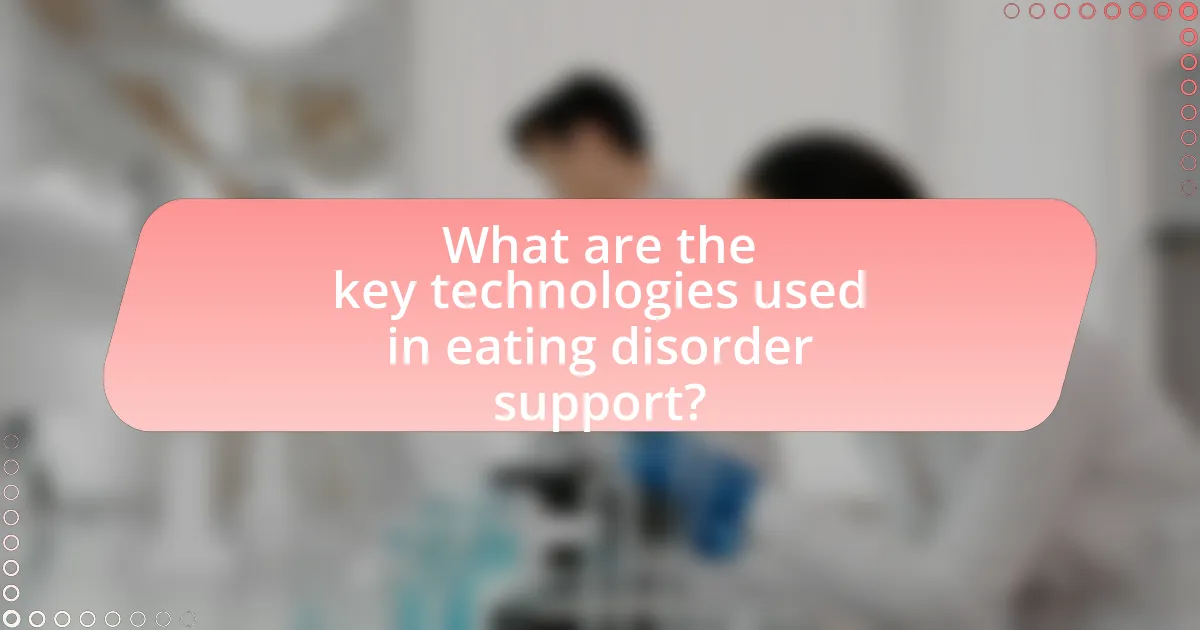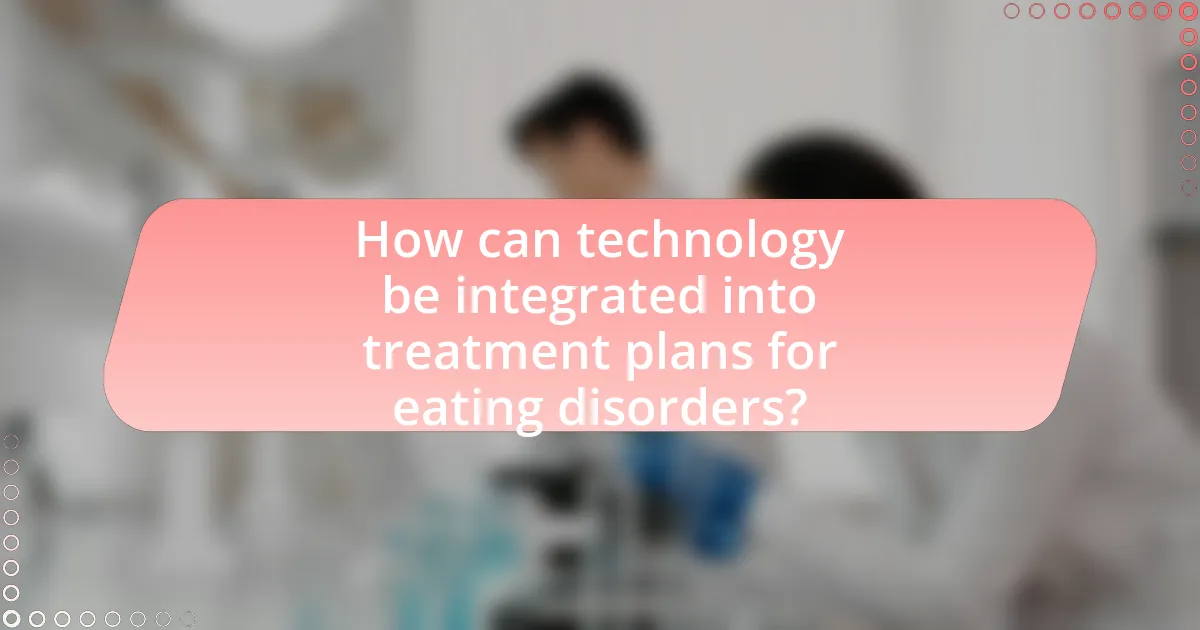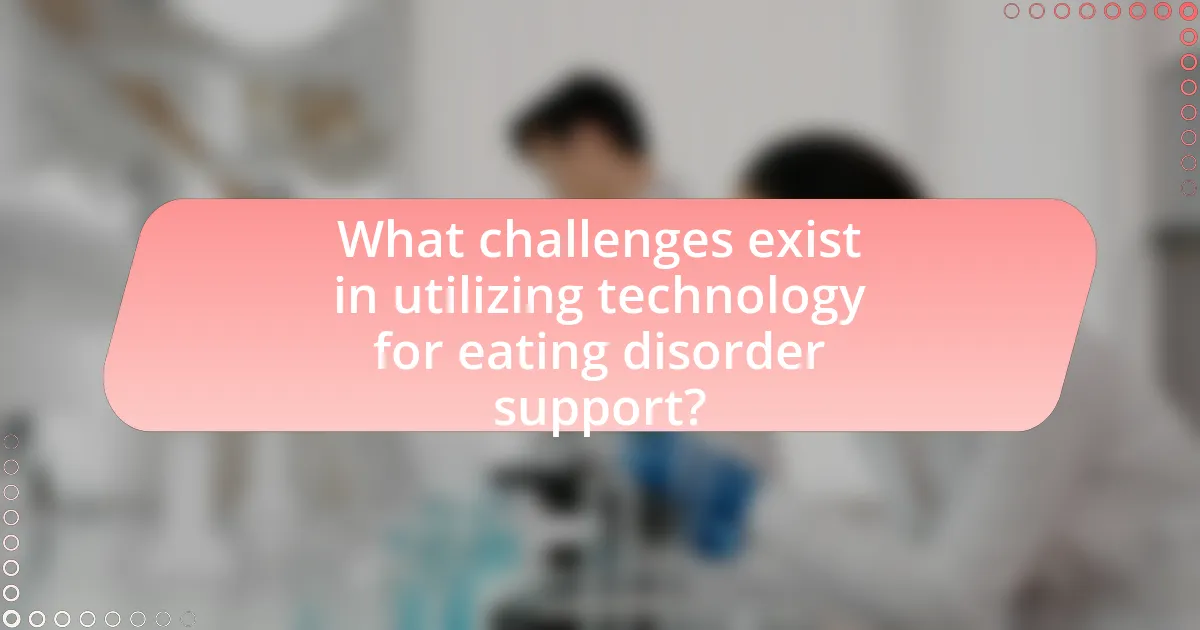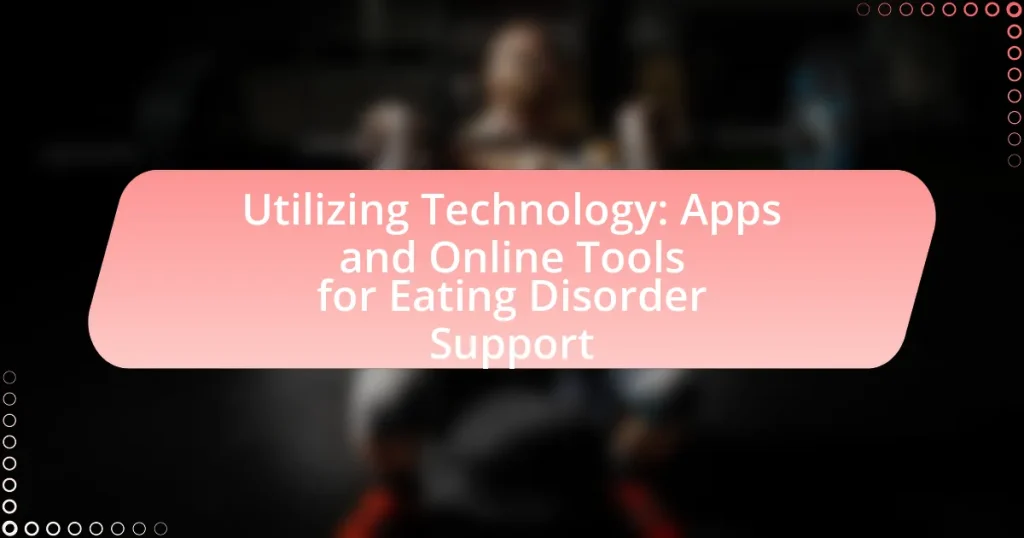The article focuses on the utilization of technology, specifically apps and online tools, for supporting individuals with eating disorders. It outlines key technologies such as mobile applications, telehealth platforms, and online support communities that enhance recovery by providing tracking tools, remote therapy access, and peer support. The article discusses how these technologies improve treatment adherence and outcomes, the essential features of effective support apps, and the role of online communities in fostering emotional support. Additionally, it addresses challenges and ethical considerations in using technology for eating disorder support, emphasizing the importance of user engagement and the selection of trustworthy resources.

What are the key technologies used in eating disorder support?
Key technologies used in eating disorder support include mobile applications, telehealth platforms, and online support communities. Mobile applications, such as Recovery Record and MyFitnessPal, provide users with tools for tracking food intake, mood, and behaviors, which can enhance self-awareness and accountability. Telehealth platforms enable remote therapy sessions, allowing individuals to access professional support from licensed therapists without geographical constraints. Online support communities, like forums and social media groups, offer peer support and shared experiences, fostering a sense of belonging and reducing isolation. These technologies have been shown to improve treatment adherence and outcomes, as evidenced by studies indicating that digital interventions can lead to significant reductions in eating disorder symptoms.
How do apps specifically aid in eating disorder recovery?
Apps specifically aid in eating disorder recovery by providing users with tools for tracking their eating habits, mood, and triggers. These applications often include features such as meal logging, symptom tracking, and educational resources that help users understand their behaviors and emotions related to food. Research indicates that mobile health interventions can significantly improve recovery outcomes; for instance, a study published in the Journal of Medical Internet Research found that participants using a mobile app for eating disorders reported reduced symptoms and improved coping strategies. Additionally, apps can facilitate communication with healthcare providers, offering a platform for support and accountability, which is crucial for effective recovery.
What features should effective eating disorder support apps include?
Effective eating disorder support apps should include features such as personalized meal tracking, mood and behavior logging, access to educational resources, community support forums, and professional guidance. Personalized meal tracking allows users to monitor their eating habits, which is crucial for recovery. Mood and behavior logging helps users identify triggers and patterns, facilitating better self-awareness. Access to educational resources provides users with information about eating disorders, promoting understanding and recovery strategies. Community support forums foster connection and shared experiences among users, which can enhance motivation and reduce feelings of isolation. Professional guidance, such as chat support with therapists or nutritionists, ensures users receive expert advice tailored to their needs. These features collectively contribute to a comprehensive support system for individuals dealing with eating disorders.
How do these features contribute to user engagement and recovery?
Features such as personalized tracking, community support, and educational resources significantly enhance user engagement and recovery in eating disorder support apps. Personalized tracking allows users to monitor their progress and set achievable goals, which fosters a sense of accomplishment and motivation. Community support features enable users to connect with others facing similar challenges, creating a supportive environment that encourages sharing experiences and coping strategies. Educational resources provide users with valuable information about their conditions, empowering them to make informed decisions about their recovery. Research indicates that social support and access to information are critical factors in the recovery process, as they can lead to improved outcomes and sustained engagement in treatment.
What role do online tools play in providing support for eating disorders?
Online tools play a crucial role in providing support for eating disorders by offering accessible resources, community support, and personalized tracking. These tools, such as mobile applications and online platforms, facilitate real-time communication with healthcare professionals, enabling users to receive guidance and feedback promptly. Research indicates that digital interventions can significantly improve treatment outcomes; for instance, a study published in the Journal of Medical Internet Research found that participants using online support tools reported reduced symptoms of eating disorders and increased motivation for recovery. Additionally, online communities provide a sense of belonging and shared experiences, which can enhance emotional support and reduce feelings of isolation among individuals struggling with eating disorders.
How can online communities enhance the support experience?
Online communities enhance the support experience by providing a platform for individuals to share their experiences, seek advice, and receive emotional support from peers facing similar challenges. These communities foster a sense of belonging and reduce feelings of isolation, which is crucial for individuals dealing with eating disorders. Research indicates that peer support can significantly improve mental health outcomes; for instance, a study published in the Journal of Medical Internet Research found that online support groups can lead to increased self-efficacy and reduced symptoms of anxiety and depression among participants. By facilitating real-time communication and access to diverse perspectives, online communities create an environment where individuals can feel understood and empowered in their recovery journey.
What types of online resources are most beneficial for individuals?
The most beneficial online resources for individuals include support groups, educational websites, mobile applications, and telehealth services. Support groups, such as those found on platforms like Reddit or specialized forums, provide community and shared experiences, which can be crucial for emotional support. Educational websites, like the National Eating Disorders Association (NEDA), offer evidence-based information about eating disorders, treatment options, and recovery strategies. Mobile applications, such as Recovery Record, assist users in tracking their eating habits and emotions, promoting self-awareness and accountability. Telehealth services enable individuals to access professional therapy and counseling remotely, increasing accessibility to mental health care. These resources collectively enhance support, education, and treatment options for individuals facing eating disorders.

How can technology be integrated into treatment plans for eating disorders?
Technology can be integrated into treatment plans for eating disorders through the use of mobile applications, telehealth services, and online support platforms. Mobile applications, such as recovery tracking tools and meal planning apps, provide users with real-time feedback and resources, enhancing self-monitoring and accountability. Telehealth services enable patients to access therapy and nutritional counseling remotely, increasing accessibility and convenience, which is crucial for individuals who may struggle with in-person visits. Online support platforms, including forums and virtual support groups, foster community and connection among individuals facing similar challenges, which can significantly improve emotional support and reduce feelings of isolation. Research indicates that these technological interventions can lead to improved treatment outcomes, as evidenced by a study published in the Journal of Medical Internet Research, which found that participants using mobile health interventions reported higher levels of engagement and satisfaction in their treatment plans.
What are the best practices for using apps in therapy?
The best practices for using apps in therapy include ensuring that the app is evidence-based, integrating it into the therapeutic process, and maintaining client engagement. Evidence-based apps have been shown to improve outcomes; for instance, a study published in the Journal of Medical Internet Research found that digital interventions can significantly enhance treatment adherence and symptom management in mental health settings. Integrating the app into therapy allows therapists to tailor its use to individual client needs, fostering a collaborative approach. Additionally, maintaining client engagement through regular check-ins and feedback can enhance the therapeutic alliance and improve overall effectiveness.
How can therapists effectively recommend specific apps to clients?
Therapists can effectively recommend specific apps to clients by assessing individual needs and aligning app features with therapeutic goals. This approach ensures that the selected apps provide relevant support, such as tracking eating habits or offering mindfulness exercises. Research indicates that personalized recommendations enhance client engagement and adherence to treatment plans, as evidenced by a study published in the Journal of Medical Internet Research, which found that tailored digital interventions significantly improved outcomes in mental health treatment. By considering factors like user interface, accessibility, and evidence-based content, therapists can guide clients toward apps that foster positive behavioral changes and support their recovery journey.
What precautions should be taken when using technology in treatment?
When using technology in treatment for eating disorders, it is crucial to ensure patient privacy and data security. This involves utilizing secure platforms that comply with regulations such as HIPAA to protect sensitive health information. Additionally, practitioners should verify the credibility of the technology and its developers to ensure evidence-based practices are being followed. Research indicates that improper use of technology can lead to misinformation and exacerbate conditions; therefore, regular monitoring and evaluation of the technology’s effectiveness are essential. Furthermore, establishing clear boundaries for technology use, such as limiting screen time and ensuring it complements rather than replaces face-to-face interactions, can enhance treatment outcomes.
How can technology facilitate communication between patients and healthcare providers?
Technology facilitates communication between patients and healthcare providers by enabling real-time interactions through telehealth platforms, messaging apps, and patient portals. These tools allow patients to easily schedule appointments, share health data, and receive timely responses from healthcare professionals. For instance, a study published in the Journal of Medical Internet Research found that telehealth services increased patient engagement and satisfaction by 70%, demonstrating the effectiveness of technology in enhancing communication. Additionally, secure messaging systems ensure that sensitive information is exchanged safely, fostering trust and improving the overall patient experience.
What tools are available for tracking progress and sharing data?
Tools available for tracking progress and sharing data include mobile applications and online platforms specifically designed for health management. Applications such as MyFitnessPal, Noom, and Recovery Record allow users to log food intake, monitor weight changes, and track emotional states, facilitating data sharing with healthcare providers. These tools often incorporate features like progress charts and community support, enhancing accountability and motivation. Research indicates that using such digital tools can improve adherence to treatment plans and foster better communication between patients and clinicians, ultimately leading to more effective management of eating disorders.
How does improved communication impact treatment outcomes?
Improved communication significantly enhances treatment outcomes by fostering better patient-provider relationships and ensuring that patients feel heard and understood. Effective communication allows healthcare providers to accurately assess patient needs, tailor interventions, and provide timely feedback, which is crucial in managing eating disorders. Research indicates that patients who engage in open dialogue with their providers are more likely to adhere to treatment plans, experience reduced symptoms, and report higher satisfaction with their care. For instance, a study published in the Journal of Eating Disorders found that improved communication strategies led to a 30% increase in treatment adherence among patients with eating disorders, demonstrating the direct correlation between communication and positive health outcomes.

What challenges exist in utilizing technology for eating disorder support?
Challenges in utilizing technology for eating disorder support include issues of accessibility, privacy concerns, and the potential for misinformation. Accessibility can be limited by socioeconomic factors, as not all individuals have reliable internet access or smartphones, which restricts their ability to use support apps. Privacy concerns arise because users may fear that their sensitive information could be exposed or misused, leading to reluctance in seeking help through digital platforms. Additionally, the proliferation of unregulated content online can result in the spread of misinformation about eating disorders, which may hinder recovery efforts and promote harmful behaviors. These challenges highlight the need for careful consideration in the design and implementation of technology-based support systems.
What are the potential drawbacks of relying on apps and online tools?
Relying on apps and online tools for eating disorder support can lead to several potential drawbacks, including a lack of personalized care and the risk of misinformation. These digital platforms often provide generalized advice that may not address individual needs, which can hinder effective treatment. Additionally, studies indicate that users may encounter inaccurate or unverified information, leading to harmful behaviors or misconceptions about eating disorders. For instance, a survey by the National Eating Disorders Association found that 70% of respondents reported encountering misleading content online, which underscores the importance of critical evaluation of digital resources.
How can users mitigate the risks associated with technology use?
Users can mitigate the risks associated with technology use by implementing strong privacy settings, regularly updating software, and being mindful of the information they share online. Strong privacy settings help protect personal data from unauthorized access, while regular software updates address security vulnerabilities that could be exploited. Additionally, users should be cautious about sharing sensitive information, as studies indicate that oversharing can lead to identity theft and other security breaches. For instance, a report by the Identity Theft Resource Center found that 1 in 15 Americans were victims of identity theft in 2020, highlighting the importance of safeguarding personal information in digital environments.
What ethical considerations should be addressed in app development?
Ethical considerations in app development for eating disorder support include user privacy, data security, informed consent, and the potential for harm. Developers must ensure that personal data is collected, stored, and processed in compliance with regulations like GDPR, which mandates user consent and the right to data access. Additionally, apps should provide clear information about how data will be used, ensuring users understand the implications of sharing their information. The potential for harm arises if the app promotes unhealthy behaviors or provides misleading information; therefore, developers should incorporate evidence-based practices and consult with mental health professionals to mitigate risks. These considerations are crucial to fostering trust and ensuring the safety of users seeking support for eating disorders.
How can users ensure they are choosing the right tools for their needs?
Users can ensure they are choosing the right tools for their needs by conducting thorough research on available options and assessing their specific requirements. This involves identifying personal goals related to eating disorder support, such as tracking progress, accessing resources, or connecting with professionals. Users should read reviews, compare features, and evaluate the credibility of the tools, including checking for endorsements from healthcare professionals or organizations specializing in eating disorders. For instance, a study published in the Journal of Medical Internet Research found that users who utilized evidence-based apps reported higher satisfaction and effectiveness in managing their conditions.
What criteria should be used to evaluate the effectiveness of support apps?
The criteria to evaluate the effectiveness of support apps include user engagement, accessibility, evidence-based content, user feedback, and measurable outcomes. User engagement assesses how frequently and actively users interact with the app, which is crucial for sustained support. Accessibility ensures that the app is usable by individuals with varying levels of technological proficiency and disabilities. Evidence-based content refers to the incorporation of scientifically validated information and techniques, which enhances the app’s credibility and effectiveness. User feedback provides insights into the app’s usability and areas for improvement, while measurable outcomes track the app’s impact on users’ mental health and recovery progress. These criteria collectively ensure that support apps are not only functional but also beneficial for users dealing with eating disorders.
How can users find trustworthy online resources for eating disorder support?
Users can find trustworthy online resources for eating disorder support by seeking out websites and organizations that are recognized by healthcare professionals and have a strong reputation in the field. Reputable sources include the National Eating Disorders Association (NEDA), which provides a wealth of information and resources, and the Academy for Eating Disorders (AED), known for its evidence-based guidelines. These organizations often feature directories of treatment providers and support groups, ensuring that users access reliable and validated information. Additionally, users should look for resources that cite scientific research or are authored by qualified professionals in psychology or nutrition, as this enhances the credibility of the information provided.
What practical tips can enhance the use of technology in eating disorder recovery?
Practical tips to enhance the use of technology in eating disorder recovery include utilizing mobile apps for tracking food intake and mood, engaging in online support groups, and accessing teletherapy services. Mobile apps like MyFitnessPal or Recovery Record allow users to log meals and emotions, which can help identify patterns and triggers. Online support groups provide a sense of community and shared experiences, which can be crucial for motivation and accountability. Teletherapy services enable individuals to connect with licensed professionals from the comfort of their homes, making therapy more accessible. Research indicates that digital interventions can significantly improve recovery outcomes, as evidenced by a study published in the Journal of Medical Internet Research, which found that participants using mobile health applications reported higher levels of engagement and better recovery metrics.


